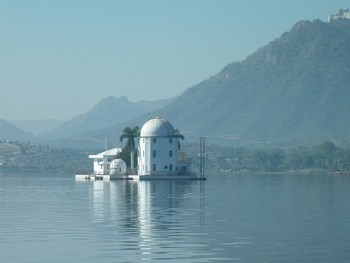 In 1567, the Mughal emperor Akbar sacked for the third time the fortress of Chittorgarh, the capital of Mewar.
Rana Udai Singh II then fled with his clan and took refuge in the ravines of Aravalli. One day he was hunting on Lake Pichola, he met a sadhu in meditation in which he asks council to build his new capital. The sage replied that the place seemed perfect, in the countryside near a lake, protected by the montains. Udai then founded his new capital at this point far less vulnerable than Chittorgarh and gave it its name. Udai Singh died in 1572 and his son, Pratap ascended the throne. He defended the city against several attacks and Mughal but must again take refuge in the hills to escape death. However, it will resume the city and the largest part of its territory, but fail to retrieve the family seat, Chittorgarh. The Mewar therfore had never been under Muslim suzerainty. After those of the Mughals, the city will have to suffer the attacks of Marathas. In 1818, Udaipur signs a treaty with the British who brought peace.
The princely state of Udaipur was maintained until 1949, then it was incorporated into the state of Rajasthan
In 1567, the Mughal emperor Akbar sacked for the third time the fortress of Chittorgarh, the capital of Mewar.
Rana Udai Singh II then fled with his clan and took refuge in the ravines of Aravalli. One day he was hunting on Lake Pichola, he met a sadhu in meditation in which he asks council to build his new capital. The sage replied that the place seemed perfect, in the countryside near a lake, protected by the montains. Udai then founded his new capital at this point far less vulnerable than Chittorgarh and gave it its name. Udai Singh died in 1572 and his son, Pratap ascended the throne. He defended the city against several attacks and Mughal but must again take refuge in the hills to escape death. However, it will resume the city and the largest part of its territory, but fail to retrieve the family seat, Chittorgarh. The Mewar therfore had never been under Muslim suzerainty. After those of the Mughals, the city will have to suffer the attacks of Marathas. In 1818, Udaipur signs a treaty with the British who brought peace.
The princely state of Udaipur was maintained until 1949, then it was incorporated into the state of Rajasthan